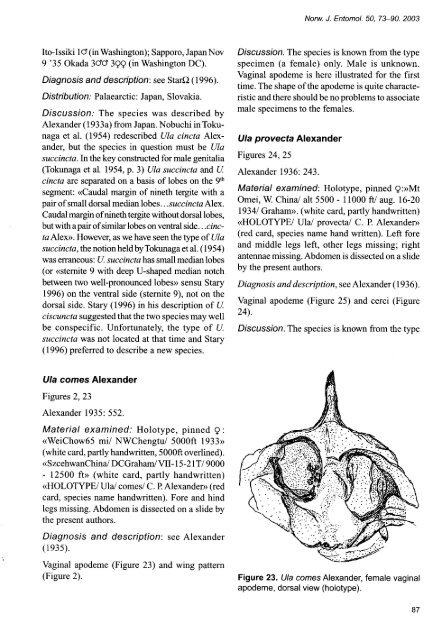Norwegian Journal of Entomology - Norsk entomologisk forening
Norwegian Journal of Entomology - Norsk entomologisk forening
Norwegian Journal of Entomology - Norsk entomologisk forening
Create successful ePaper yourself
Turn your PDF publications into a flip-book with our unique Google optimized e-Paper software.
Ito-Issiki Id' (in Washington); Sapporo, Japan Nov<br />
9 '35 Okada 3cJ'cJ' 399 (in Washington DC).<br />
Diagnosis and description: see StarQ (1996).<br />
Distribution: Palaearctic: Japan, Slovakia.<br />
Discussion: The species was described by<br />
Alexander (1933a) from Japan. Nobuchi in Tokunaga<br />
et al. (1954) redescribed uta cincta Alexander,<br />
but the species in question must be uta<br />
succincta. Inthe key constructed for male genitalia<br />
(Tokunaga et al 1954, p. 3) Ula succincta and U<br />
cincta are separated on a basis <strong>of</strong>lobes on the 9 th<br />
segment: «Caudal margin <strong>of</strong> nineth tergite with a<br />
pair <strong>of</strong>small dorsal median lobes.. .succincta Alex.<br />
Caudal margin <strong>of</strong>nineth tergite without dorsal lobes,<br />
butwith apair <strong>of</strong>similar lobes on ventral side.. .cincta<br />
Alex». However, as we have seen the type <strong>of</strong>Ula<br />
succincta, the notion held byTokunaga et al. (1954)<br />
was erraneous: U succincta has small median lobes<br />
(or «sternite 9 with deep U-shaped median notch<br />
between two well-pronounced lobes» sensu Stary<br />
1996) on the ventral side (sternite 9), not on the<br />
dorsal side. Stary (1996) in his description <strong>of</strong> U<br />
ciscuncta suggested that the two species may well<br />
be conspecific. Unfortunately, the type <strong>of</strong> U<br />
succincta was not located at that time and Stary<br />
(1996) preferred to describe a new species.<br />
Ula comes Alexander<br />
Figures 2, 23<br />
Alexander 1935: 552.<br />
Material examined: Holotype, pinned 9:<br />
«WeiChow65 mil NWChengtul 5000ft 1933»<br />
(white card, partly handwritten, 5000ft overlined).<br />
«SzcehwanChinal DCGraham/VII-15-2lTI 9000<br />
- 12500 ft» (white card, partly handwritten)<br />
«HOLOTYPEI Ulal comesl C. P. Alexander» (red<br />
card, species name handwritten). Fore and hind<br />
legs missing. Abdomen is dissected on a slide by<br />
the present authors.<br />
Diagnosis and description: see Alexander<br />
(1935).<br />
Vaginal apodeme (Figure 23) and wing pattern<br />
(Figure 2).<br />
Norw. J. Entomol. 50, 73-90. 2003<br />
Discussion. The species is known from the type<br />
specimen (a female) only. Male is unknown.<br />
Vaginal apodeme is here illustrated for the first<br />
time. The shape <strong>of</strong>the apodeme is quite characteristic<br />
and there should be no problems to associate<br />
male specimens to the females.<br />
Ula provecta Alexander<br />
Figures 24, 25<br />
Alexander 1936: 243.<br />
Material examined: Holotype, pinned 9:»Mt<br />
Omei, W Chinal alt 5500 - 11000 ftl aug. 16-20<br />
19341 Graham». (white card, partly handwritten)<br />
«HOLOTYPEI Ulal provectal C. P. Alexander»<br />
(red card, species name hand written). Left fore<br />
and middle legs left, other legs missing; right<br />
antennae missing. Abdomen is dissected on a slide<br />
by the present authors.<br />
Diagnosis anddescription, see Alexander (1936).<br />
Vaginal apodeme (Figure 25) and cerci (Figure<br />
24).<br />
Discussion. The species is known from the type<br />
Figure 23. Uta comes Alexander, female vaginal<br />
apodeme, dorsal view (holotype).<br />
87

















